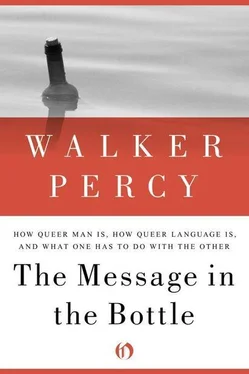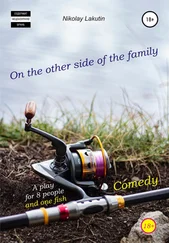Being neither critic nor philosopher, I feel free to venture into the no-man’s-land between the two and to deal with those very metaphors which scandalize the philosopher because they are “wrong” and scandalize the critic because they are accidental. Philosophers don’t think much of metaphor to begin with and critics can hardly have much use for folk metaphors, those cases where one stumbles into beauty without deserving it or working for it. Is it possible to get a line on metaphor, to figure out by a kind of lay empiricism what is going on in those poetic metaphors and folk metaphors where the wrongness most patently coincides with the beauty?
When the Mississippi Negro calls the Seeburg record player a seabird, it is not enough to say that he is making a mistake. It is also not enough to say that he is making a colorful and poetic contribution to language. It is less than useless to say that in calling a machine a bird he is regressing into totemism, etc. And it is not even accurate to say that he knows what the thing is and then gives it a picturesque if farfetched name. In some fashion or other, he conceives the machine under the symbol seabird, a fashion, moreover, in regard to which we must be very wary in applying the words right or wrong, poetic or discursive, etc. Certainly the machine is not a seabird and no one imagines that it is, whatever the semanticists may say. Yet we may make a long cast and guess that in conceiving it as a seabird, the namer conceives it with richer overtones of meaning and, in some sense neither literal nor figurative, even as being more truly what it is than under its barbarous title Seeburg automatic coin record player. There is a danger at this point in my being misunderstood as trying to strike a blow for the poetic against the technical, feeling against science, and on the usual aesthetic grounds. But my intention is quite the reverse. I mean to call attention to the rather remarkable fact that in conceiving the machine under the “wrong” symbol seabird, we somehow know it better, conceive it in a more plenary fashion, have more immediate access to it, than under its descriptive title. The sooner we get rid of the old quarrel of artistic versus prosaic as constituting the grounds of our preference, the sooner we shall be able to understand what is going on. Given these old alternatives, I’ll take the prosaic any day — but what is going on here is of far greater moment.
The moments and elements of this meaning-situation are more easily grasped in the example of the boy seeing the strange bird in Alabama. The first notable moment occurred when he saw the bird. What struck him at once was the extremely distinctive character of the bird’s flight — its very great speed, the effect of alternation of the wings, the sudden plummeting into the woods. This so distinctive and incommunicable something — the word which occurs to one is Hopkins’s “inscape”—the boy perceived perfectly. It is this very uniqueness which Hopkins specifies in inscape: “the unspeakable stress of pitch, distinctiveness, selving.”
The next moment is, for our purposes, the most remarkable of all, because it can receive no explanation in the conventional sign theory of meaning. The boy, having perfectly perceived the flight of the hawk, now suffers a sort of disability, a tension, even a sense of imminence! He puts the peculiar question, What is that bird? and puts it importunately. He is really anxious to know. But to know what? What sort of answer does he hope to hear? What in fact is the meaning of his extraordinary question? Why does he want an answer at all? He has already apprehended the hawk in the vividest, most plenary way — a sight he will never forget as long as he lives. What more will he know by having the bird named? (No more, say the semioticists, and he deceives himself if he imagines that he does.)
We have come already to the heart of the question, and a very large question it is. For the situation of the boy in Alabama is very much the same sort of thing as what Cassirer calls the “mythico-religious Urphenomenon.” Cassirer, following Usener and Spieth, emphasized the situation in which the primitive comes face to face with something which is both entirely new to him and strikingly distinctive, so distinctive that it might be said to have a presence —an oddly shaped termite mound, a particular body of water, a particular abandoned road. And it is in the two ways in which this tensional encounter is resolved that the Urphenomenon is said to beget metaphor and myth. The Tro or momentary god is born of the sense of unformulated presence of the thing; the metaphor arises from the symbolic act in which the emotional cry of the beholder becomes the vehicle by which the thing is conceived, the name of the thing. “In the vocables of speech and in primitive mythic configurations, the same inner process finds its consummation: they are both resolutions of an inner tension, the representation of subjective impulses and excitations in definite object forms and figures.”
One recognizes the situation in one’s own experience, that is, the metaphorical part of it. Everyone has a blue-dollar hawk in his childhood, especially if he grew up in the South or West, where place names are so prone to poetic corruption. Chaisson Falls, named properly after its discoverer, becomes Chasin’ Falls. Scapegoat Mountain, named after some Indian tale, becomes Scrapegoat Mountain — mythic wheels within wheels. And wonderfully: Purgatoire River becomes Picketwire River. A boy grows up in the shadow of a great purple range called Music Mountain after some forgotten episode — perhaps the pioneers’ first hoedown after they came through the pass. But this is not how the boy conceives it. When the late afternoon sun strikes the great pile in a certain light, the ridges turn gold, the crevasses are cast into a thundering blue shadow, then it is that he imagines that the wind comes soughing down the gorges with a deep organ note. The name, mysterious to him, tends to validate some equally mysterious inscape of the mountain.
So far so good. But the question on which everything depends and which is too often assumed to be settled without ever having been asked is this: Given this situation and its two characteristics upon which all agree, the peculiar presence or distinctiveness of the object beheld and the peculiar need of the beholder — is this “need” and its satisfaction instrumental or ontological? That is to say, is it the function of metaphor merely to diminish tension, or is it a discoverer of being? Does it fit into the general scheme of need-satisfactions? — and here it doesn’t matter much whether we are talking about the ordinary pragmatic view or Cassirer’s symbolic form: both operate in an instrumental mode, one, that of biological adaption; the other, according to the necessities of the mythic consciousness. Neither provides for a real knowing, a truth-saying about what a being is. Or is it of such a nature that at least two sorts of realities must be allowed: one, the distinctive something beheld; two, the beholder (actually two beholders, one who gives the symbol and one who receives the symbol as meaningful, the Namer and the Hearer), whose special, if imperfect, gift it is to know and affirm this something for what it actually is? The question can’t be bracketed, for the two paths lead in opposite directions, and everything one says henceforth on the subject must be understood from one or the other perspective. In this primitive encounter which is at the basis of man’s cognitive orientation in the world, either we are trafficking in psychological satisfactions or we are dealing with that unique joy which marks man’s ordainment to being and the knowing of it.
Читать дальше












